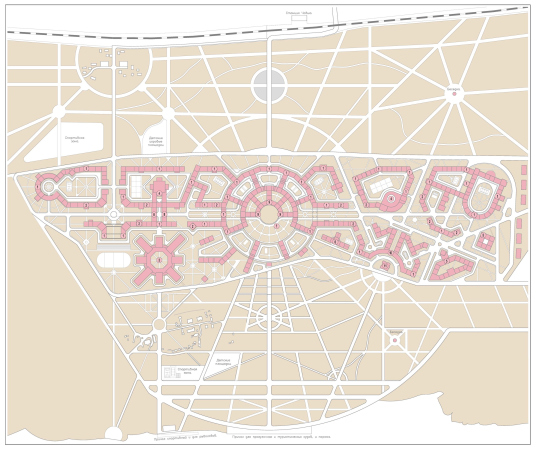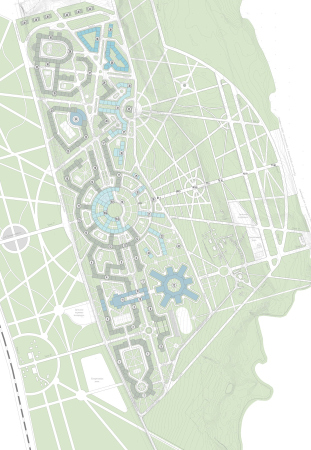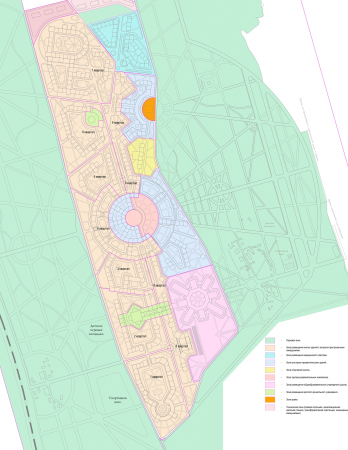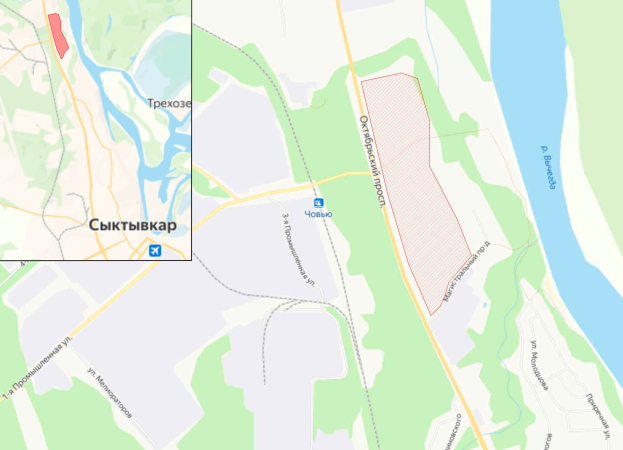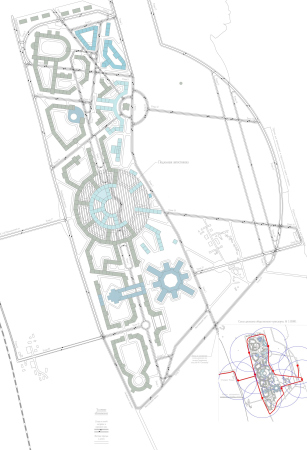The project of Yugyd-Choi (“Bright Mountain”). Syktyvkar, Komi Republic. Mikhail Filippov architects
Copyright: © Mikhail Filippov
A 45-hectare town will be situated on a terrain with a height difference of 14 meters. The architectural ensembles occupy the elongated top part, gradually descending to the river in terraces. On the bank of the river, there is a large chunk of woodland, which, according to the project, will be made into a landscaped park. If we take a look at the master plan, we will see that the Vychegda River (which is, by the way, is 600 meters wide here, almost like the Neva, so there is an opportunity for creating sweeping city views seen from the water) flows down below, while the city is centered around a cultural cluster with a circular square, museums, theaters, and galleries. In the left part of Yugyd-Choi, there is a school with a kindergarten adjoining it, as well as a sports, music, and art schools. In the right part, according to the architect’s plan, there will be the Church of St. Spiridon Trimifuntsky and the spiritual center, and then, even more to the right, there will be a medical cluster.
Along the entire length of the city, there are nine residential blocks from 3 to 6 stories high, designed in the traditional aesthetics and inspired, as was already said, by the center of St. Petersburg, the most beautiful city in the world, protected by UNESCO. This choice was not accidental. St. Petersburg is one of the few cities that have retained the hierarchy of their skylines: it is dominated by golden spires and domes, which mark the churches and important public buildings. And here, in Yugyd-Choi, the skyline will be dominated by the church dome and the belfry.
The project of Yugyd-Choi (“Bright Mountain”). Syktyvkar, Komi Republic. Mikhail Filippov architects
Copyright: © Mikhail Filippov
The terraced composition of the Bright Mountain
The above-mentioned Gorky Gorod became the starting point of the project for a number of reasons. First, this is a fulfilled prophecy (back in 1984, Mikhail Filippov won an international competition “Style 2001”, organized by the magazines JA and A+U, displaying a series of watercolor paintings, in which the average neighborhood consisting of prefabricated houses gradually gave way to classic architecture, and more than 30 years later the architect did build such a town). Second, Gorky Gorod, in which Filippov’s town planning ideas were tested, became an incredibly popular ski resort, the gem in the crown of Sochi. And third, the customer of Yugyd-Choi, Elena Soboleva, head of the Syktyvkar Housing Construction Fund, specially began to look for the architect Filippov, having visited Gorky Gorod and being amazed at the beauty of the architecture and the town’s festive atmosphere.
The project of Yugyd-Choi (“Bright Mountain”). Syktyvkar, Komi Republic. Mikhail Filippov architects
Copyright: © Mikhail Filippov
For Yugyd-Choi, Mikhail Filippov came up with a terraced composition, which is a favorite technique of his. The first things that come to mind are the terraced ensembles in the Pavchinskaya Poima, on the Krymskaya Embankment, or, again, in Gorky Gorod. Even on a site with a zero height difference – like in “Italian Quarter” on Moscow’s Dolgorukovskaya Street – the architect designs buildings that descend gradually in terraces, recreating a town on a hill, which is always a pretty sight to see. Yugyd-Choi has a natural height difference of 14 meters, descending to the river, and the architecture additionally emphasizes it. The terraced composition of the main residential quarter of Yugyd-Choi, which surrounds the main square, does look striking. Just like in “Italian Quarter”, the buildings gradually decrease in height as they get closer to the square. The buildings that form the square are low-rise galleries and museums. The overall composition is like an antique theater, in the spirit of the Roman theater of Marcellus of II century A.D., which was completed in the later centuries. Courtyards are formed between the residential buildings – and this is a separate subject.
The project of Yugyd-Choi (“Bright Mountain”). Syktyvkar, Komi Republic. Mikhail Filippov architects
Copyright: © Mikhail Filippov
The courtyards of the Silver and Platinum ages
The housing stock in Yugyd-Choi is presented by large “city block” houses of various shapes interspersed with a system of courtyards. The houses overlook the streets with seamless classicist facades, the way you would expect to see in most historical cities. The inner yards are significantly improved in comparison with old cities. What may serve as an example are the famous silver-age buildings of St. Petersburg. These are the courtyards with the colonnade of the Benois House on Kamennoostrovsky avenue and the Tolstoy House designed by Lidval on Rubinstein Street. It was in these buildings that the courtyards became spacious for the first time and received grand facades, solemn arches and propylaea. Today it is extremely fashionable and expensive housing, a hallmark of the city. Mikhail Filippov explored the theme of a grand facade in the courtyard in many of his projects: in “Roman House”, in “Italian Quarters”, and others – now he is taking it to a new level in Yudyd-Choi. The difference is that the yards will become even more spacious and still greener, and the distance between the buildings will be at least 42m, which will help to avoid the undesirable “window-to-window” effect.
The project of Yugyd-Choi (“Bright Mountain”). Syktyvkar, Komi Republic. Mikhail Filippov architects
Copyright: © Mikhail Filippov
This means that in addition to the city facades, executed in the “human-friendly” classical scale, based on architecture of orders, the residents will get excellent yard facades, as well as semi-private vehicle-free spaces (the cars will be forwarded to underground parking garages).
The project of Yugyd-Choi (“Bright Mountain”). Syktyvkar, Komi Republic. Mikhail Filippov architects
Copyright: © Mikhail Filippov
The five rays of the Northern Versailles
The secret of Mikhail Filippov’s town planning system lies in superimposing the radial system over the rectangular Hippodamus grid, plus the curves of the rivers and ravines, made into embankments. Basically, this is how all the great cities of the world are wired. This complexity, brought to order, and this balance of system and freedom, make the city look picturesque, creating vantage points commanding beautiful views, on condition that you have traditional architecture. In Yugyd-Choi, the architect masterfully combines several radial and rectangular systems. Wherever they cross, the city blocks take on a more complex shape, the houses even sometimes stand with their corners facing the street, the way you can sometimes see in Rome, giving the city fabric liveliness and compositional dynamics. The five rays of Yugyd Choi’s park promenades put one in the mind of the famous three rays of Versailles or St. Petersburg, because the rays run from the city’s central square. What it ends up being is some kind of a “radiant city” executed in a classical manner.
Fly, Petal, Fly!
The educational cluster of Yugyd-Choi is represented in full effect. The secondary school was designed by Mikhail Filippov according to modern standards, and in accordance with the requirements of the Ministry of Education – with computer classes and everything else that is needed for modern education. The building consists of eight independent units, which form the heart of the circular schoolyard like flower petals. The courtyard is circled by a warm passage connecting all the buildings and functions: elementary, middle and high school, assembly hall, gymnasium and swimming pool, and so on. There is also a kindergarten adjacent to the school; there are music, art and sports schools nearby.
The project of Yugyd-Choi (“Bright Mountain”). Syktyvkar, Komi Republic. Mikhail Filippov architects
Copyright: © Mikhail Filippov
The church dome as a city landmark
Particular importance in the Yugyd-Choi project is attached to the position of the Church of St. Spiridon Trimifuntsky. The church stands over a steep precipice, and is seen from everywhere: from below, i.e from the side of the river and the park, and from the city. All the streets from the northern residential areas, from the hospital, and from the city center lead to the church. The church’s belfry is the highest point of Yudyd-Choi, just like the belfry of Ivan the Great in the Moscow Kremlin. It is designed as a landmark of this place.
The project of Yugyd-Choi (“Bright Mountain”). Syktyvkar, Komi Republic. Mikhail Filippov architects
Copyright: © Mikhail Filippov
Unlike in a European city, where cathedrals are immersed in a dense urban fabric, the traditions of Russian urban planning are different: here the church is self-sufficient: it stands in the middle of the square, and you can go around it and see it from all sides. The Church of St. Spiridon Trimifuntsky follows the same town planning logic: it stands on a circular square, which in this case is deliberately separated from the town’s main square (also circular) by a shopping mall. According to Mikhail Filippov, the building of the church will be there at the end of several streets, which will definitely “lead to the temple”.
The project of Yugyd-Choi (“Bright Mountain”). Syktyvkar, Komi Republic. Mikhail Filippov architects
Copyright: © Mikhail Filippov
We recover faster in beautiful surroundings
Not far away from the Church of St. Spiridon Trimifuntsky, literally across the street, there will be a medical cluster bordering an enormous park. The hospital, just like the entire town, is designed in the classical tradition of architecture of orders. According to the Russian tradition, hospitals were built in the form of palaces and estates among the greenery, and often these buildings looked more luxurious than royal residences, despite the fact that not necessarily the ruling classes were treated there. Everyone knows the Moscow Sklifosovsky Institute, the former Count Sheremetev Infirmary – a hospital for the poor, as well as the First Gradskaya Hospital on Leninsky Avenue – the former Golitsyn Hospital, built in 1802 by Matvey Kazakov, which today is intended for all segments of the population, but still looks as representative as a royal estate. This was done because we recover faster in beautiful surroundings. That is why, when in London, in 2013, the Chelsea Veterans Society decided to replace a utilitarian 1960s hospital building in the Chelsea Hospital ensemble, which did not suit them aesthetically, they called in a neoclassical architect. The Yugyd-Choi medical cluster is also designed as a classical ensemble immersed in greenery and commanding beautiful views of the city, the river, and the temple.
The project of Yugyd-Choi (“Bright Mountain”). Syktyvkar, Komi Republic. Mikhail Filippov architects
Copyright: © Mikhail Filippov
The “garden city” and the hallmark of the Komi Republic
Since the residential blocks of Yugyd-Choi have a human-friendly height from 3 to 6 floors (which does not affect a rather large yield of useful floor space per hectare), the houses do not rise above the trees, and the city literally swims in greenery. This turns Yugyd-Choi into a garden city – not in the sense of following Howard’s model (even though there are parallels with it) but because of the enormous amount of vegetation. The extensive park with “ray” promenades descends down to the water, where recreational facilities for all generations will be created, including bicycle roads, fishing spots, and a quay yard for rowboats and small riverboats. It is obvious that Yugyd-Choi – “Bright Mountain” will become a center of attraction not only for the residents of the town itself, but for the whole of Syktyvkar. And the beauty of the streets, the dignity and variety of classical architecture, and the picturesque city panoramas can make it the hallmark of the Komi Republic and the entire North-West region.




